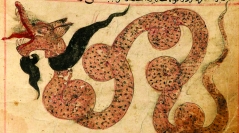

 Anthropozoologica
51 (1) - Pages 41-54
Anthropozoologica
51 (1) - Pages 41-54In 1513 the famous Turkish navigator, geographer and cartographer, the admiral Pîrî Reis, drew a large planisphere showing the entire known world of the time. Today only a fragment of this work remains, conserved at the Topkapi Sarayi Museum in Istanbul (Turkey) and referred to as the Carte de l’Atlantique. This map represents one of the most controversial, mysterious and beautiful documents in the history of cartography. The aim of this study is to analyse the zoomorphic representations of the Pîrî Reis map, investigating the sources of their iconography as well as focusing on their zoological and cultural meanings. We carried out a review of existing literature on this topic, attempting to provide an updated scientific interpretation of the animals portrayed, considering the zoological knowledge assumed to exist at the beginning of the 16th century and the probable cultural background of Pîrî Reis. Our interpretation demonstrates that many of the animals represented in the Pîrî Reis map conform to the European and Near-Eastern late medieval iconographic tradition. On the other hand, other zoomorphic representations, such as Caribbean parrots, appear unrelated to any previous source and could possibly have been copied from Columbus’ lost map.
Cartography, iconography, animals, fabulous creatures, 16th century